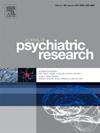基线和动态血浆/唾液内分泌以及线性/非线性心脏测量在重度抑郁症患者和密切匹配的健康受试者之间的差异:一项为期3天的地塞米松/美替拉酮联合夜间研究
IF 3.2
2区 医学
Q1 PSYCHIATRY
引用次数: 0
摘要
背景:重度抑郁症(MDD)一直与下丘脑-垂体-肾上腺(HPA)轴和自主神经系统(ANS) (re-)活动异常相关,然而,结果往往相互矛盾。方法本研究同时对hpa -轴和ANS活性和反应性进行了3天的多指标评估,以更好地表征MDD患者的基线和动态神经内分泌改变,考虑到多种个体因素。因此,我们通过同时评估早晨血浆(CORT, ACTH, copeptin)和觉醒反应唾液(CORT, DHEA, DHEA-s)内分泌测量,以及静息心率(HR)及其变异性(HRV)的多重线性和非线性测量,在(基线,第1天)之前和之后,研究了20名未服药的MDD患者和20名仔细匹配的健康对照(HC)之间的组差异。第2天)和地塞米松(hpa轴抑制,第3天)药物-内分泌刺激,控制儿童创伤(CT)史。结果只有基线血浆CORT和ACTH水平(MDD >;HC)和静息HR均为3天。动态血浆水平和所有唾液内分泌测量以及所有HRV测量均无差异。基线HR是MDD诊断的唯一显著预测因子。结论使用紧密匹配的HC进行详细的基线和动态神经内分泌比较表明,MDD患者的神经内分泌改变少于预期。这些结果挑战了先前的发现,并支持在研究神经内分泌生物标志物时精确匹配的重要性,因为先前报道的发现可能依赖于未考虑的个体差异,而不是群体差异。本文章由计算机程序翻译,如有差异,请以英文原文为准。
Differences in baseline and dynamic plasma/saliva endocrine and linear/non-linear heart measures between patients with major depression and closely-matched healthy subjects: A 3-day combined overnight dexamethasone/metyrapone challenge study
Background
Major depressive disorder (MDD) has been consistently associated with hypothalamic-pituitary-adrenal (HPA)-axis and autonomic nervous system (ANS) (re-)activity abnormalities, however, often with conflicting results.
Methods
This study offers a concurrent multi-measure assessment of both HPA-axis and ANS activity and reactivity over 3 days to better characterize baseline and dynamic neuroendocrine alterations in MDD accounting for multiple individual factors. We therefore investigated group differences between 20 unmedicated MDD patients and 20 carefully-matched healthy controls (HC) by simultaneously assessing morning plasma (CORT, ACTH, copeptin) and awakening response saliva (CORT, DHEA, DHEA-s) endocrine measures, as well as multiple linear and non-linear measures of resting heart rate (HR) and its variability (HRV), before (baseline, day 1) and after a successive overnight metyrapone (HPA-axis stimulation, day 2) and dexamethasone (HPA-axis suppression, day 3) pharmaco-endocrine challenge, controlling for childhood trauma (CT) history.
Results
Statistically significant group differences emerged only for baseline plasma CORT and ACTH levels (MDD > HC) and resting HR in all 3 days. No differences were found in dynamic plasma levels and all saliva endocrine measures, as well as all HRV measures. Baseline HR was the only significant predictor for MDD diagnosis.
Conclusions
Our detailed baseline and dynamic neuroendocrine comparison using closely matched HC indicates fewer neuroendocrine alterations in MDD than expected. These results challenge prior findings and support the importance of exact matching when investigating neuroendocrine biomarkers, as previously reported findings may rely on unaccounted individual but not group differences.
求助全文
通过发布文献求助,成功后即可免费获取论文全文。
去求助
来源期刊

Journal of psychiatric research
医学-精神病学
CiteScore
7.30
自引率
2.10%
发文量
622
审稿时长
130 days
期刊介绍:
Founded in 1961 to report on the latest work in psychiatry and cognate disciplines, the Journal of Psychiatric Research is dedicated to innovative and timely studies of four important areas of research:
(1) clinical studies of all disciplines relating to psychiatric illness, as well as normal human behaviour, including biochemical, physiological, genetic, environmental, social, psychological and epidemiological factors;
(2) basic studies pertaining to psychiatry in such fields as neuropsychopharmacology, neuroendocrinology, electrophysiology, genetics, experimental psychology and epidemiology;
(3) the growing application of clinical laboratory techniques in psychiatry, including imagery and spectroscopy of the brain, molecular biology and computer sciences;
 求助内容:
求助内容: 应助结果提醒方式:
应助结果提醒方式:


